Hyundai Equus 2016 Owner's Manual
Manufacturer: HYUNDAI, Model Year: 2016, Model line: Equus, Model: Hyundai Equus 2016Pages: 477, PDF Size: 16.25 MB
Page 301 of 477
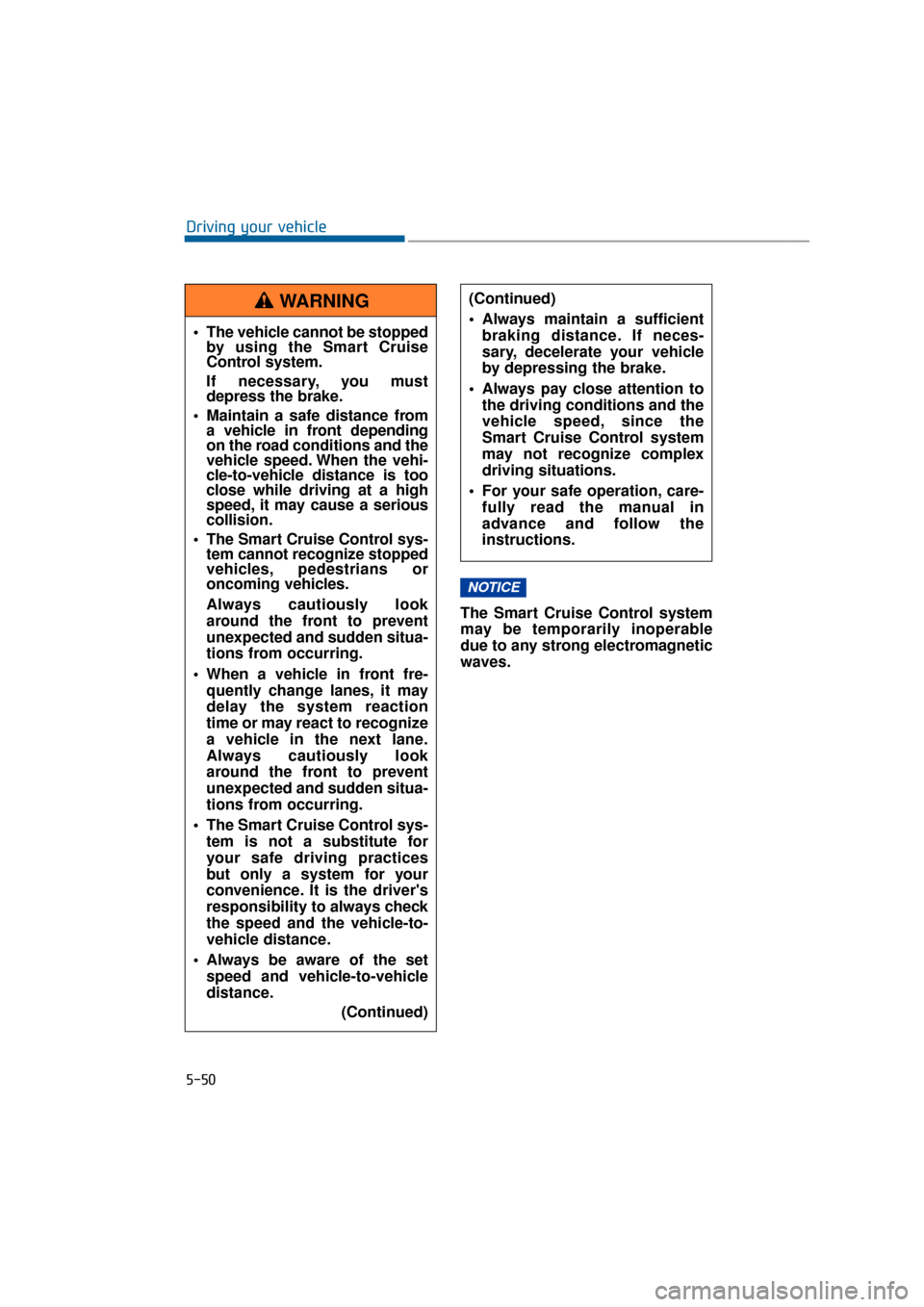
The Smart Cruise Control system
may be temporarily inoperable
due to any strong electromagnetic
waves.
NOTICE
5-50
Driving your vehicle The vehicle cannot be stopped by using the Smart Cruise
Control system.
If necessary, you must
depress the brake.
Maintain a safe distance from a vehicle in front depending
on the road conditions and the
vehicle speed. When the vehi-
cle-to-vehicle distance is too
close while driving at a high
speed, it may cause a serious
collision.
The Smart Cruise Control sys- tem cannot recognize stopped
vehicles, pedestrians or
oncoming vehicles.
Always cautiously look
around the front to prevent
unexpected and sudden situa-
tions from occurring.
When a vehicle in front fre- quently change lanes, it may
delay the system reaction
time or may react to recognize
a vehicle in the next lane.
Always cautiously look
around the front to prevent
unexpected and sudden situa-
tions from occurring.
The Smart Cruise Control sys- tem is not a substitute for
your safe driving practices
but only a system for your
convenience. It is the driver's
responsibility to always check
the speed and the vehicle-to-
vehicle distance.
Always be aware of the set speed and vehicle-to-vehicle
distance.
(Continued)
(Continued)
Always maintain a sufficientbraking distance. If neces-
sary, decelerate your vehicle
by depressing the brake.
Always pay close attention to the driving conditions and the
vehicle speed, since the
Smart Cruise Control system
may not recognize complex
driving situations.
For your safe operation, care- fully read the manual in
advance and follow the
instructions.WARNING
Page 302 of 477
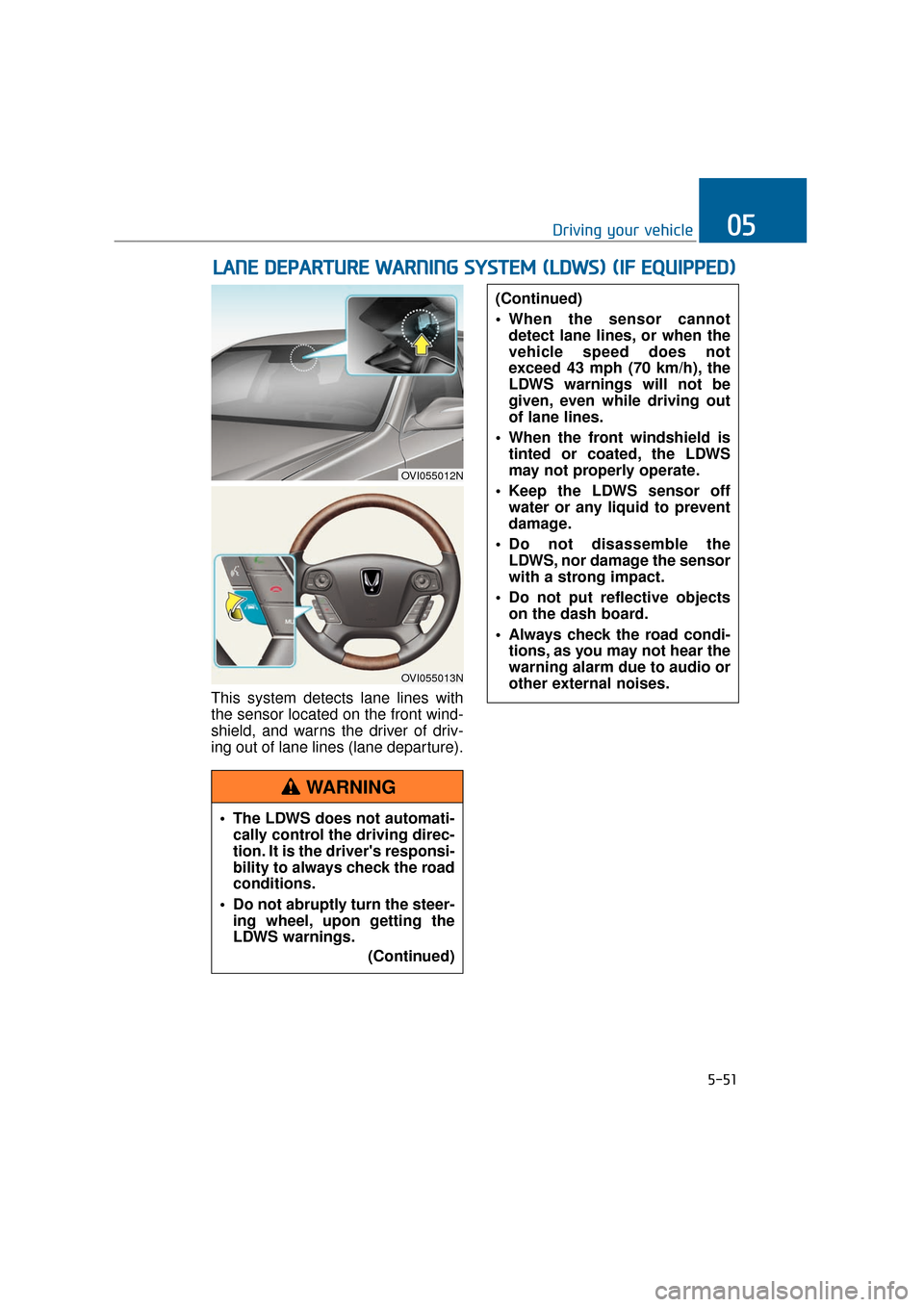
This system detects lane lines with
the sensor located on the front wind-
shield, and warns the driver of driv-
ing out of lane lines (lane departure).
L LA
A N
N E
E
D
D E
EP
P A
A R
RT
TU
U R
RE
E
W
W A
AR
RN
N I
IN
N G
G
S
S Y
Y S
ST
T E
EM
M
(
( L
L D
D W
W S
S)
)
(
( I
IF
F
E
E Q
Q U
UI
IP
P P
PE
ED
D )
)
5-51
Driving your vehicle05
OVI055012N
OVI055013N
The LDWS does not automati-
cally control the driving direc-
tion. It is the driver's responsi-
bility to always check the road
conditions.
Do not abruptly turn the steer- ing wheel, upon getting the
LDWS warnings.
(Continued)
(Continued)
When the sensor cannotdetect lane lines, or when the
vehicle speed does not
exceed 43 mph (70 km/h), the
LDWS warnings will not be
given, even while driving out
of lane lines.
When the front windshield is tinted or coated, the LDWS
may not properly operate.
Keep the LDWS sensor off water or any liquid to prevent
damage.
Do not disassemble the LDWS, nor damage the sensor
with a strong impact.
Do not put reflective objects on the dash board.
Always check the road condi- tions, as you may not hear the
warning alarm due to audio or
other external noises.
WARNING
Page 303 of 477
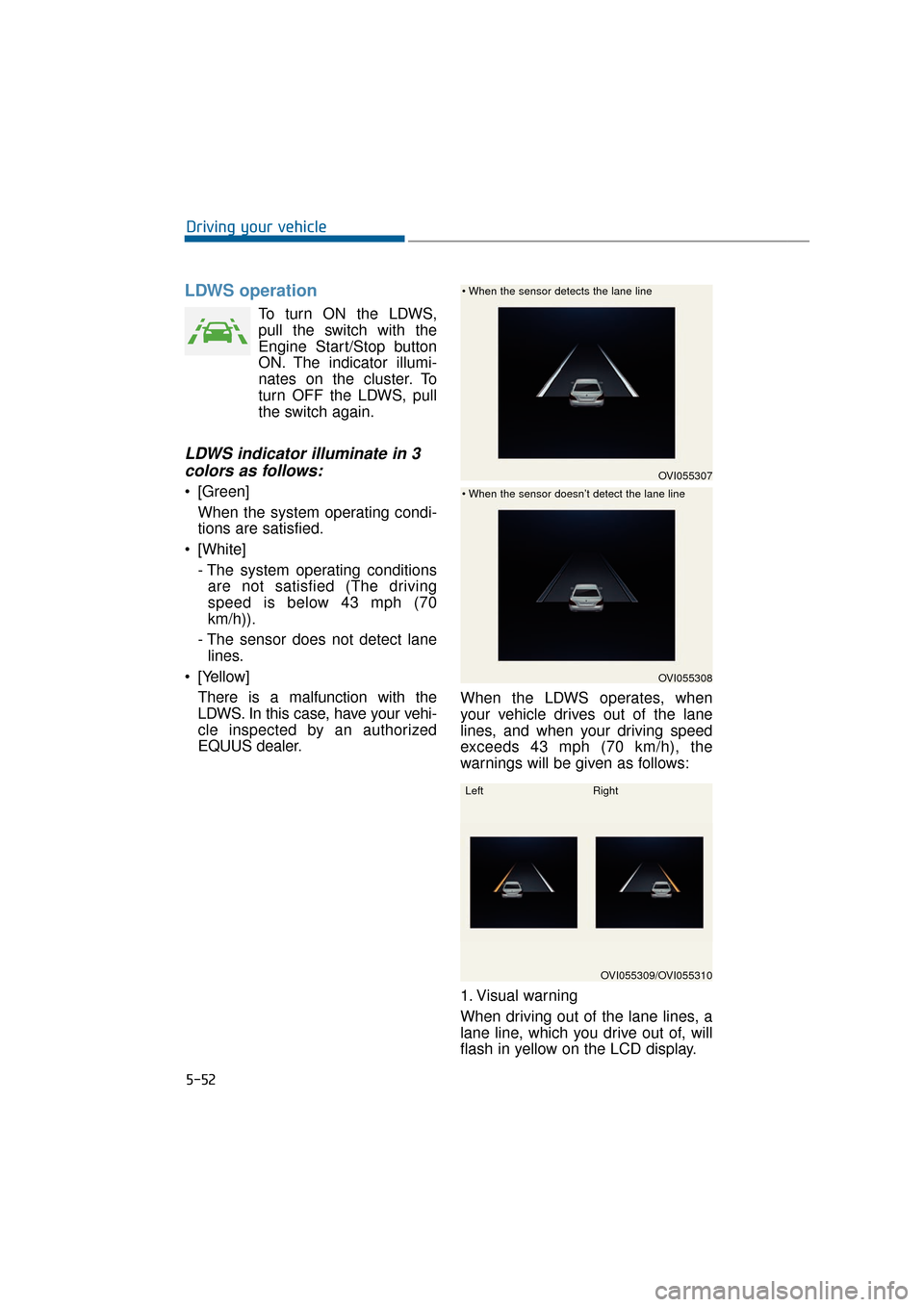
LDWS operation
To turn ON the LDWS,
pull the switch with the
Engine Start/Stop button
ON. The indicator illumi-
nates on the cluster. To
turn OFF the LDWS, pull
the switch again.
LDWS indicator illuminate in 3colors as follows:
[Green]
When the system operating condi-
tions are satisfied.
[White] - The system operating conditionsare not satisfied (The driving
speed is below 43 mph (70
km/h)).
- The sensor does not detect lane lines.
[Yellow] There is a malfunction with the
LDWS. In this case, have your vehi-
cle inspected by an authorized
EQUUS dealer. When the LDWS operates, when
your vehicle drives out of the lane
lines, and when your driving speed
exceeds 43 mph (70 km/h), the
warnings will be given as follows:
1. Visual warning
When driving out of the lane lines, a
lane line, which you drive out of, will
flash in yellow on the LCD display.
5-52
Driving your vehicle
OVI055307
OVI055308
OVI055309/OVI055310
Left
Right
Page 304 of 477
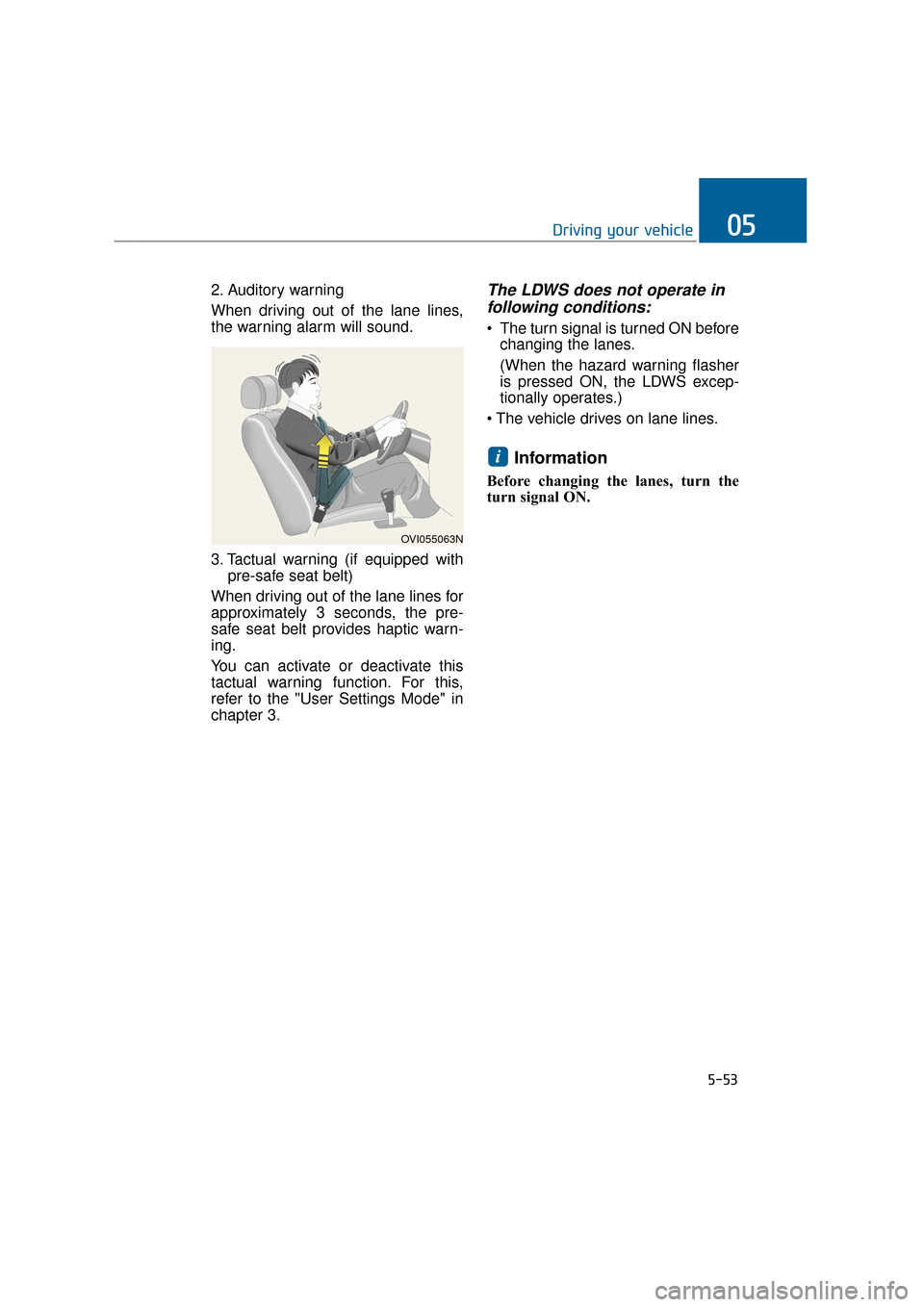
2. Auditory warning
When driving out of the lane lines,
the warning alarm will sound.
3. Tactual warning (if equipped withpre-safe seat belt)
When driving out of the lane lines for
approximately 3 seconds, the pre-
safe seat belt provides haptic warn-
ing.
You can activate or deactivate this
tactual warning function. For this,
refer to the "User Settings Mode" in
chapter 3.The LDWS does not operate in following conditions:
The turn signal is turned ON before
changing the lanes.
(When the hazard warning flasher
is pressed ON, the LDWS excep-
tionally operates.)
Information
Before changing the lanes, turn the
turn signal ON.
i
5-53
Driving your vehicle05
OVI055063N
Page 305 of 477
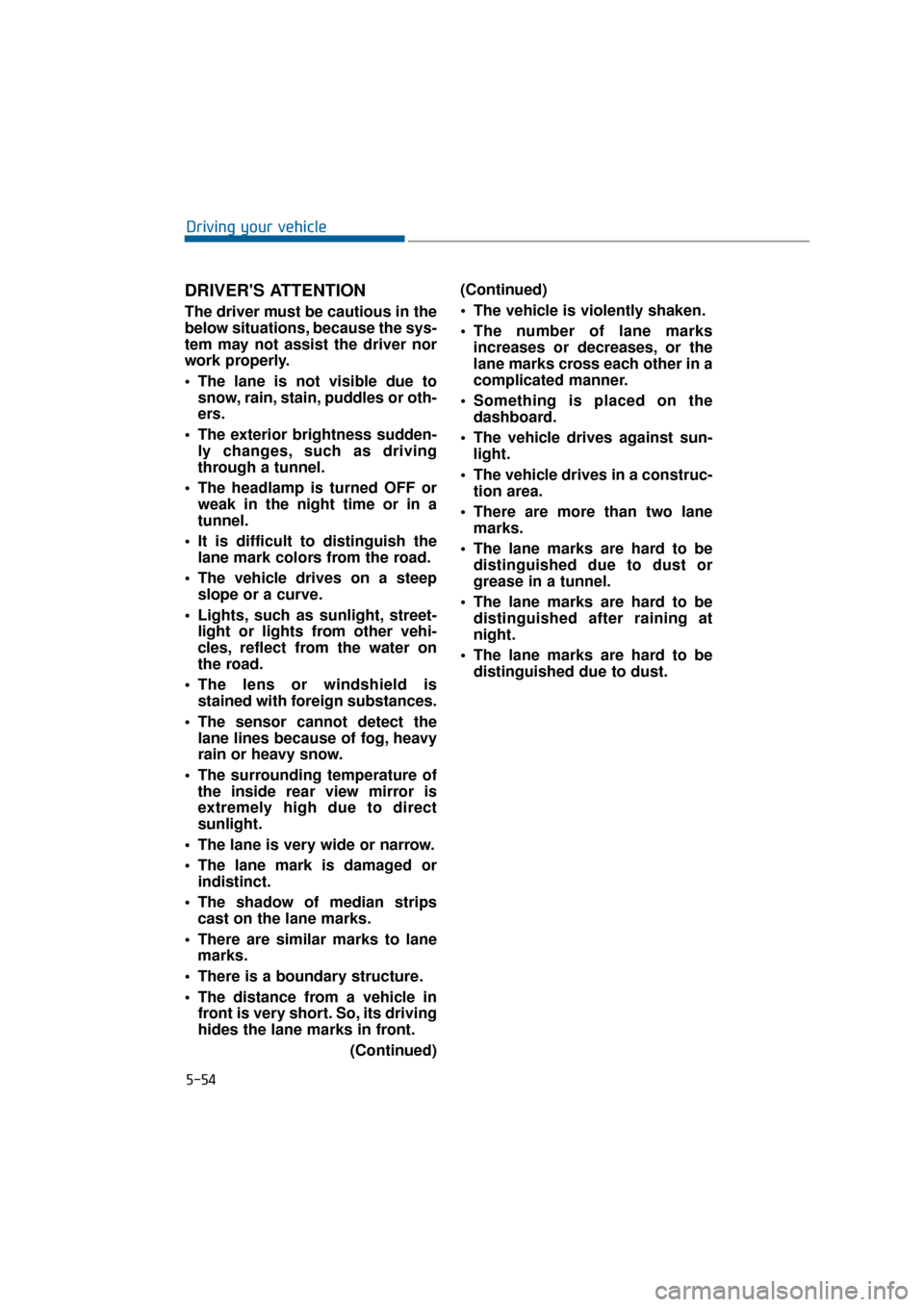
DRIVER'S ATTENTION
The driver must be cautious in the
below situations, because the sys-
tem may not assist the driver nor
work properly.
The lane is not visible due tosnow, rain, stain, puddles or oth-
ers.
The exterior brightness sudden- ly changes, such as driving
through a tunnel.
The headlamp is turned OFF or weak in the night time or in a
tunnel.
It is difficult to distinguish the lane mark colors from the road.
The vehicle drives on a steep slope or a curve.
Lights, such as sunlight, street- light or lights from other vehi-
cles, reflect from the water on
the road.
The lens or windshield is stained with foreign substances.
The sensor cannot detect the lane lines because of fog, heavy
rain or heavy snow.
The surrounding temperature of the inside rear view mirror is
extremely high due to direct
sunlight.
The lane is very wide or narrow.
The lane mark is damaged or indistinct.
The shadow of median strips cast on the lane marks.
There are similar marks to lane marks.
There is a boundary structure.
The distance from a vehicle in front is very short. So, its driving
hides the lane marks in front.
(Continued)(Continued)
The vehicle is violently shaken.
The number of lane marks
increases or decreases, or the
lane marks cross each other in a
complicated manner.
Something is placed on the dashboard.
The vehicle drives against sun- light.
The vehicle drives in a construc- tion area.
There are more than two lane marks.
The lane marks are hard to be distinguished due to dust or
grease in a tunnel.
The lane marks are hard to be distinguished after raining at
night.
The lane marks are hard to be distinguished due to dust.
5-54
Driving your vehicle
Page 306 of 477
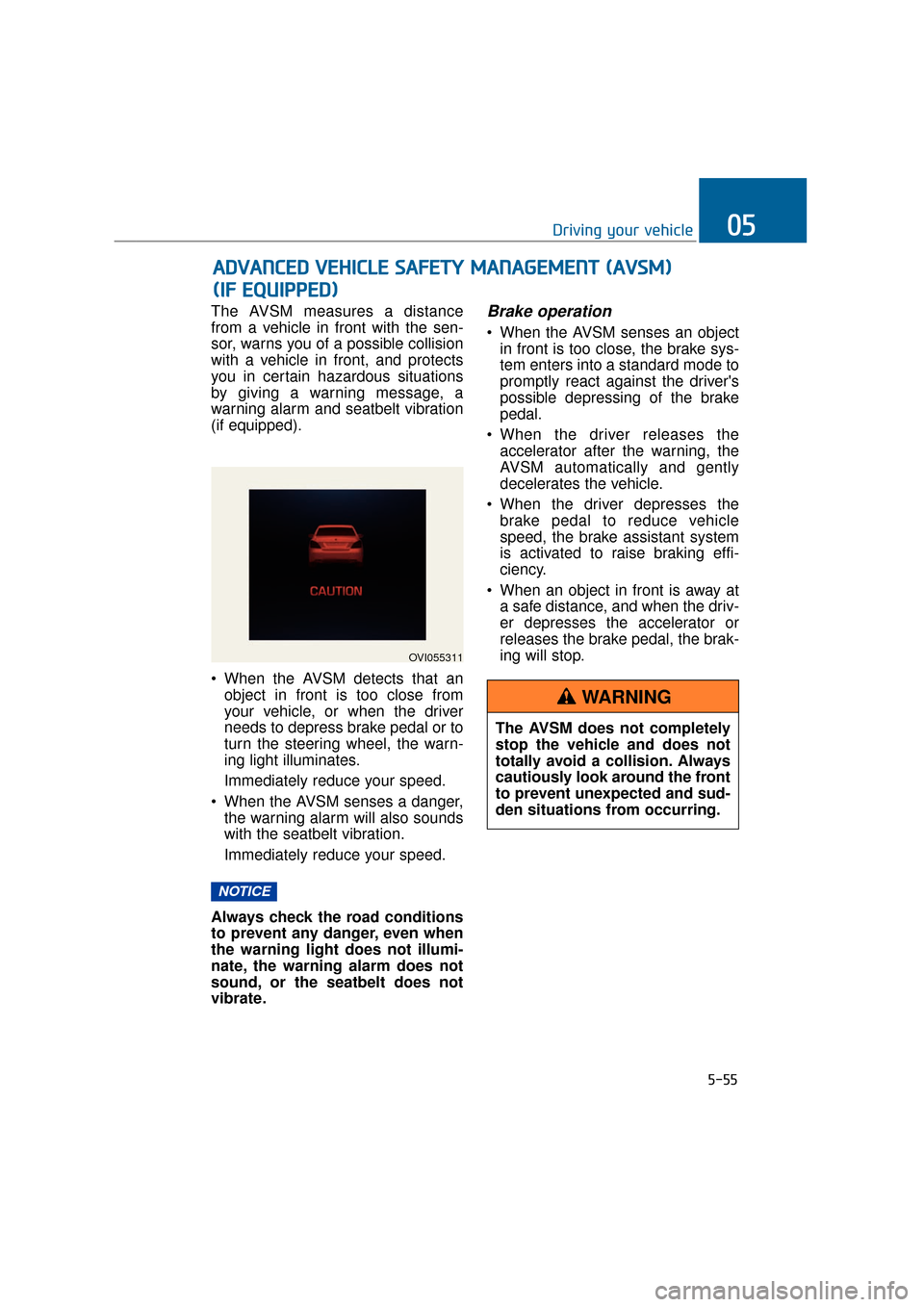
5-55
Driving your vehicle05
The AVSM measures a distance
from a vehicle in front with the sen-
sor, warns you of a possible collision
with a vehicle in front, and protects
you in certain hazardous situations
by giving a warning message, a
warning alarm and seatbelt vibration
(if equipped).
When the AVSM detects that anobject in front is too close from
your vehicle, or when the driver
needs to depress brake pedal or to
turn the steering wheel, the warn-
ing light illuminates.
Immediately reduce your speed.
When the AVSM senses a danger, the warning alarm will also sounds
with the seatbelt vibration.
Immediately reduce your speed.
Always check the road conditions
to prevent any danger, even when
the warning light does not illumi-
nate, the warning alarm does not
sound, or the seatbelt does not
vibrate.Brake operation
When the AVSM senses an object in front is too close, the brake sys-
tem enters into a standard mode to
promptly react against the driver's
possible depressing of the brake
pedal.
When the driver releases the accelerator after the warning, the
AVSM automatically and gently
decelerates the vehicle.
When the driver depresses the brake pedal to reduce vehicle
speed, the brake assistant system
is activated to raise braking effi-
ciency.
When an object in front is away at a safe distance, and when the driv-
er depresses the accelerator or
releases the brake pedal, the brak-
ing will stop.
NOTICE
A AD
DV
VA
A N
N C
CE
E D
D
V
V E
EH
H I
IC
C L
LE
E
S
S A
A F
FE
E T
T Y
Y
M
M A
AN
N A
AG
G E
EM
M E
EN
N T
T
(
( A
A V
VS
SM
M )
)
(
( I
IF
F
E
E Q
Q U
UI
IP
P P
PE
ED
D )
)
OVI055311
The AVSM does not completely
stop the vehicle and does not
totally avoid a collision. Always
cautiously look around the front
to prevent unexpected and sud-
den situations from occurring.
WARNING
Page 307 of 477
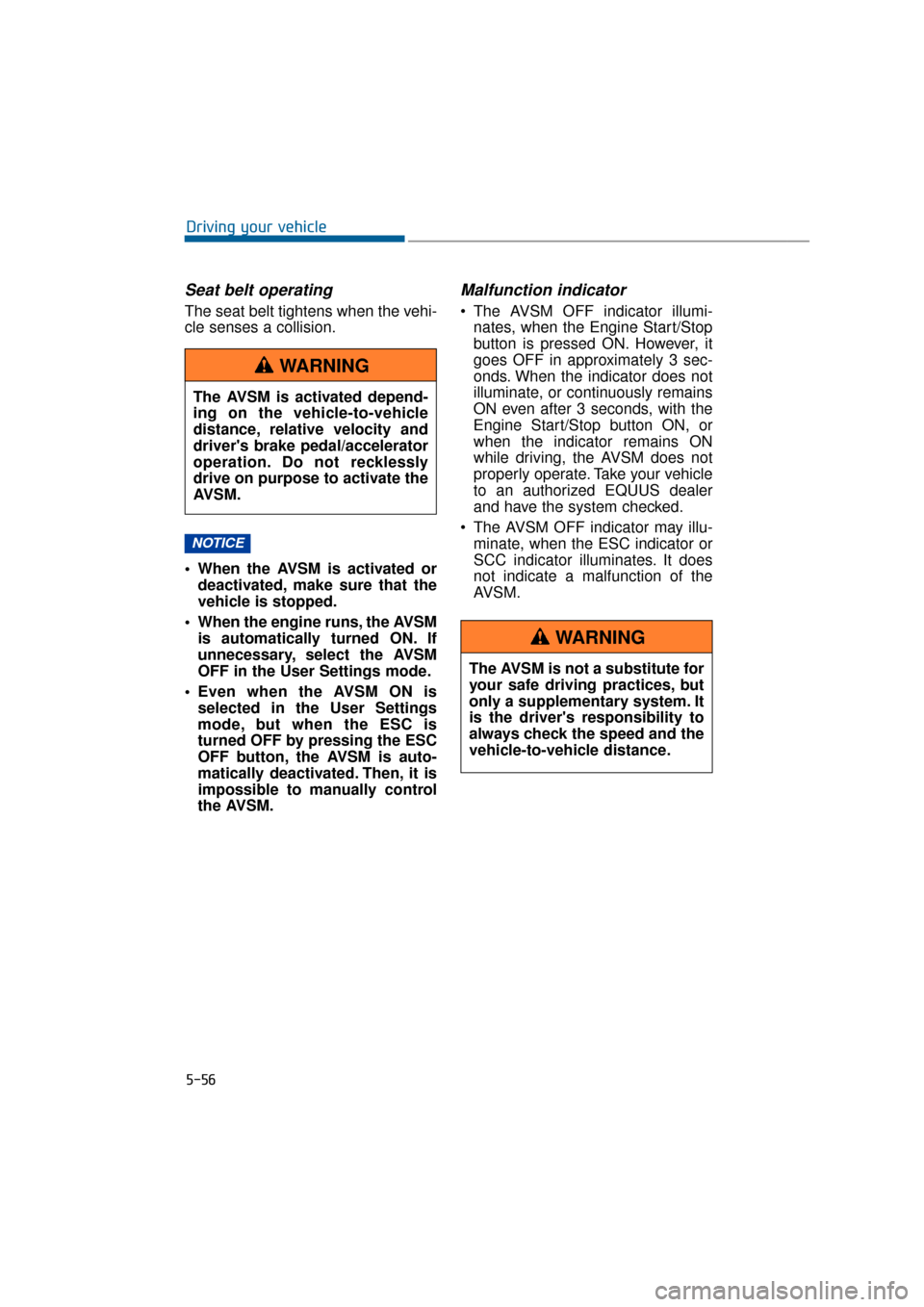
Seat belt operating
The seat belt tightens when the vehi-
cle senses a collision.
When the AVSM is activated ordeactivated, make sure that the
vehicle is stopped.
When the engine runs, the AVSM is automatically turned ON. If
unnecessary, select the AVSM
OFF in the User Settings mode.
Even when the AVSM ON is selected in the User Settings
mode, but when the ESC is
turned OFF by pressing the ESC
OFF button, the AVSM is auto-
matically deactivated. Then, it is
impossible to manually control
the AVSM.
Malfunction indicator
The AVSM OFF indicator illumi-nates, when the Engine Start/Stop
button is pressed ON. However, it
goes OFF in approximately 3 sec-
onds. When the indicator does not
illuminate, or continuously remains
ON even after 3 seconds, with the
Engine Start/Stop button ON, or
when the indicator remains ON
while driving, the AVSM does not
properly operate. Take your vehicle
to an authorized EQUUS dealer
and have the system checked.
The AVSM OFF indicator may illu- minate, when the ESC indicator or
SCC indicator illuminates. It does
not indicate a malfunction of the
AVSM.
NOTICE
5-56
Driving your vehicle
The AVSM is not a substitute for
your safe driving practices, but
only a supplementary system. It
is the driver's responsibility to
always check the speed and the
vehicle-to-vehicle distance.
WARNING
The AVSM is activated depend-
ing on the vehicle-to-vehicle
distance, relative velocity and
driver's brake pedal/accelerator
operation. Do not recklessly
drive on purpose to activate the
AVSM.
WARNING
Page 308 of 477
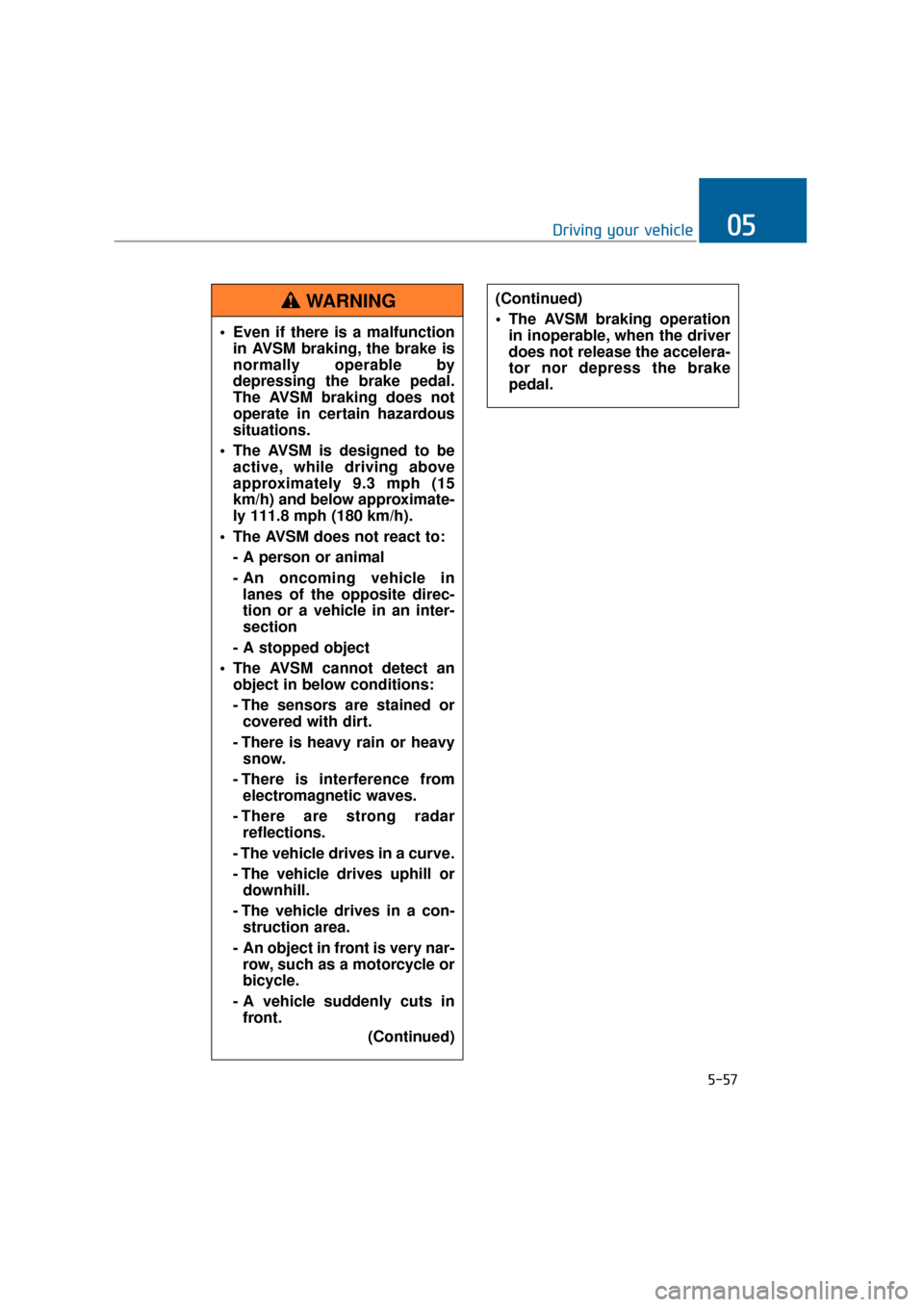
5-57
Driving your vehicle05
Even if there is a malfunctionin AVSM braking, the brake is
normally operable by
depressing the brake pedal.
The AVSM braking does not
operate in certain hazardous
situations.
The AVSM is designed to be active, while driving above
approximately 9.3 mph (15
km/h) and below approximate-
ly 111.8 mph (180 km/h).
The AVSM does not react to: - A person or animal
- An oncoming vehicle inlanes of the opposite direc-
tion or a vehicle in an inter-
section
- A stopped object
The AVSM cannot detect an object in below conditions:
- The sensors are stained orcovered with dirt.
- There is heavy rain or heavy snow.
- There is interference from electromagnetic waves.
- There are strong radar reflections.
- The vehicle drives in a curve.
- The vehicle drives uphill or downhill.
- The vehicle drives in a con- struction area.
- An object in front is very nar- row, such as a motorcycle or
bicycle.
- A vehicle suddenly cuts in front.
(Continued)
(Continued)
The AVSM braking operationin inoperable, when the driver
does not release the accelera-
tor nor depress the brake
pedal.WARNING
Page 309 of 477
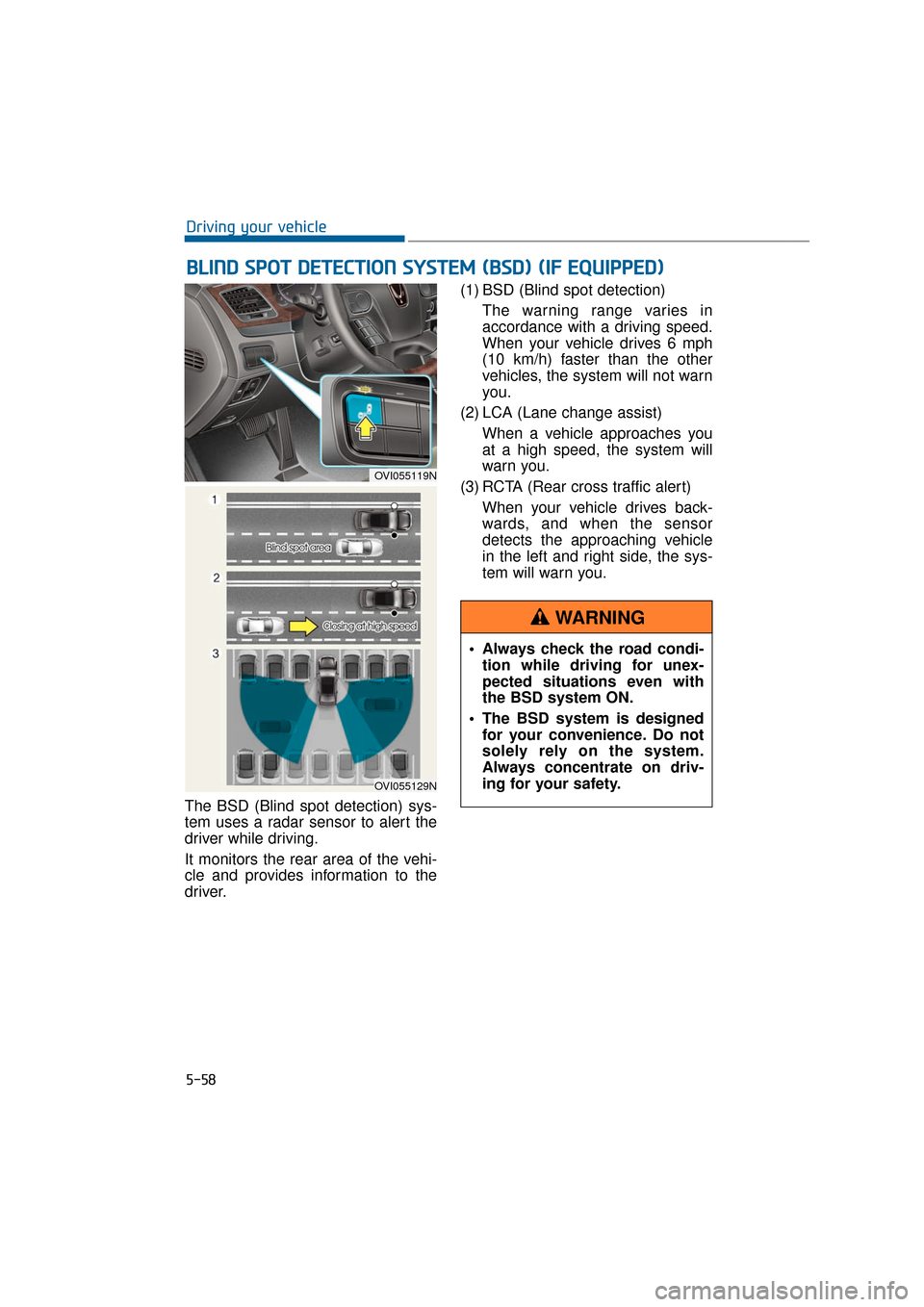
The BSD (Blind spot detection) sys-
tem uses a radar sensor to alert the
driver while driving.
It monitors the rear area of the vehi-
cle and provides information to the
driver.(1) BSD (Blind spot detection)
The warning range varies in
accordance with a driving speed.
When your vehicle drives 6 mph
(10 km/h) faster than the other
vehicles, the system will not warn
you.
(2) LCA (Lane change assist) When a vehicle approaches you
at a high speed, the system will
warn you.
(3) RCTA (Rear cross traffic alert) When your vehicle drives back-
wards, and when the sensor
detects the approaching vehicle
in the left and right side, the sys-
tem will warn you.
5-58
Driving your vehicle
B BL
LI
IN
N D
D
S
S P
P O
O T
T
D
D E
ET
T E
EC
CT
T I
IO
O N
N
S
S Y
Y S
ST
T E
EM
M
(
( B
B S
SD
D )
)
(
( I
IF
F
E
E Q
Q U
UI
IP
P P
PE
ED
D )
)
OVI055119N
OVI055129N
Always check the road condi-
tion while driving for unex-
pected situations even with
the BSD system ON.
The BSD system is designed for your convenience. Do not
solely rely on the system.
Always concentrate on driv-
ing for your safety.
WARNING
Page 310 of 477
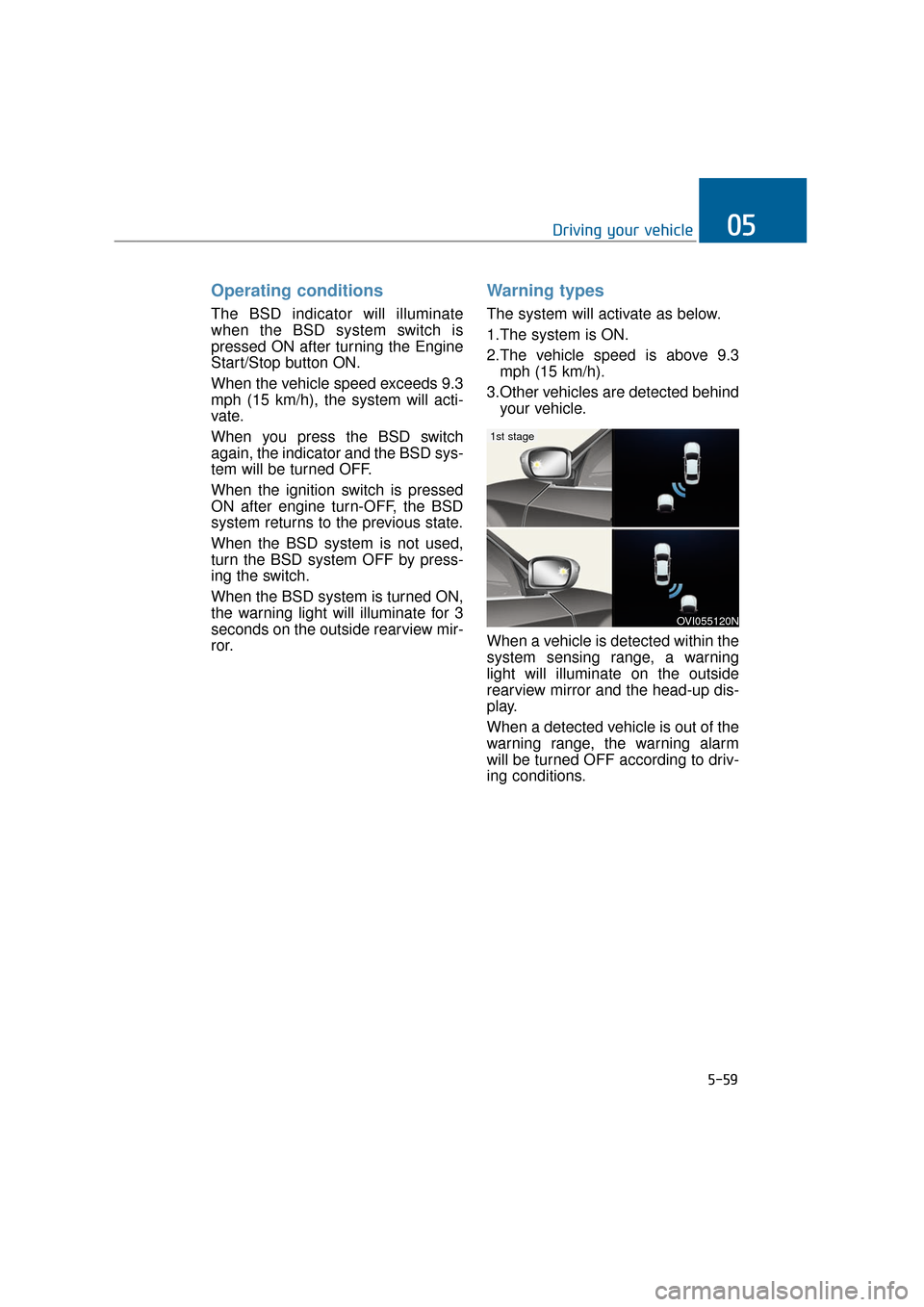
Operating conditions
The BSD indicator will illuminate
when the BSD system switch is
pressed ON after turning the Engine
Start/Stop button ON.
When the vehicle speed exceeds 9.3
mph (15 km/h), the system will acti-
vate.
When you press the BSD switch
again, the indicator and the BSD sys-
tem will be turned OFF.
When the ignition switch is pressed
ON after engine turn-OFF, the BSD
system returns to the previous state.
When the BSD system is not used,
turn the BSD system OFF by press-
ing the switch.
When the BSD system is turned ON,
the warning light will illuminate for 3
seconds on the outside rearview mir-
ror.
Warning types
The system will activate as below.
1.The system is ON.
2.The vehicle speed is above 9.3mph (15 km/h).
3.Other vehicles are detected behind your vehicle.
When a vehicle is detected within the
system sensing range, a warning
light will illuminate on the outside
rearview mirror and the head-up dis-
play.
When a detected vehicle is out of the
warning range, the warning alarm
will be turned OFF according to driv-
ing conditions.
5-59
Driving your vehicle05
OVI055120N
1st stage